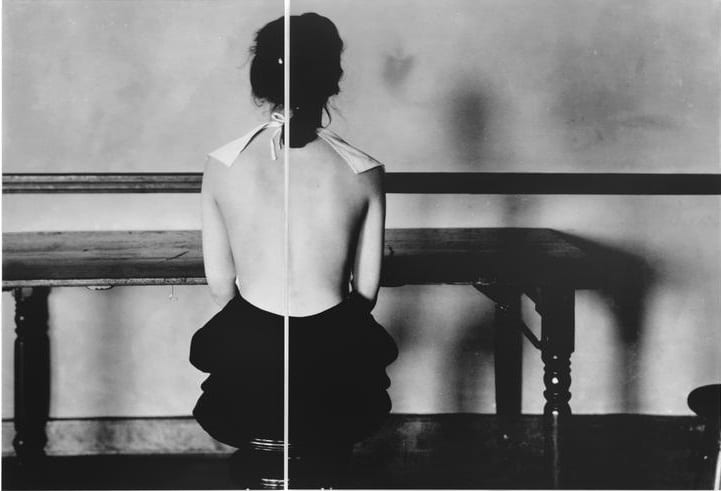Lisa Oppenheim (b.1975) reexamines the history of textile production through the lens of labour and physicality as a combined narrative. Recalling Karl Marx’s ideas of alienation, whereby the production processes of capitalism distance the worker from the final product, she investigates the shift in production of textiles from the domestic sphere to the factory from the 19th century onwards, through three new series.
Central to the exhibition is a new series of photographic works entitled Spine. Based on early 20th century images from the Library of Congress archive, the photographs depict the backs of workers, and were taken by documentary photographer and sociologist Lewis Hine. In 1915, Hine produced portraits of textile workers in the Boston area to illustrate the effects of manufacturing on young women’s bodies. Oppenheim reproduces Hine’s clinical but oddly sensual images at human scale, each life-sized piece bisected vertically along the subject’s spine. The physical bifurcation of the image itself underscores their asymmetry, whilst its enlargement returns it to the scale of a human body that must be confronted in real space and time.
Oppenheim often employs materials or by-products of material processes which are considered unusable or even defective. In her Remnant series, on display in the main gallery, she creates photographic negatives using textile fragments sourced from approximately the same time period and locations as Hine’s photographs. These textiles, originally mass produced, survive now only as craft products – low-cost scraps for quilting. Oppenheim subjects the fragments to a process of extreme enlargement and presents them in large-scale format, to reveal their material structure, again emphasising the physical labour inherent in their mechanical production. Finally, in her Jacquard Weave series, Oppenheim uses the photographs made from these vintage fragments as a basis for translating them back into textiles. With each iteration, the colours are inverted: the photograph is the colour negative of the original textile, whose colours are again inverted in the programming of the Jacquard loom.
The final compositions are as much a result of Oppenheim’s own editing processes as they are artefacts of the different apparatuses that produce them. Mechanical production and digital reproduction repeatedly switch places with one another, blurring boundaries and pushing the physical limits of each medium. As with much of Oppenheim’s work, in these series distances in time collapse, as past events and antiquated processes are transformed into a material present.
Lisa Oppenheim: A Durable Web runs until 21 October at Tanya Bonakdar Gallery, New York. For more information: www.tanyabonakdargallery.com
Credits:
1. Lisa Oppenheim: A Durable Web.





